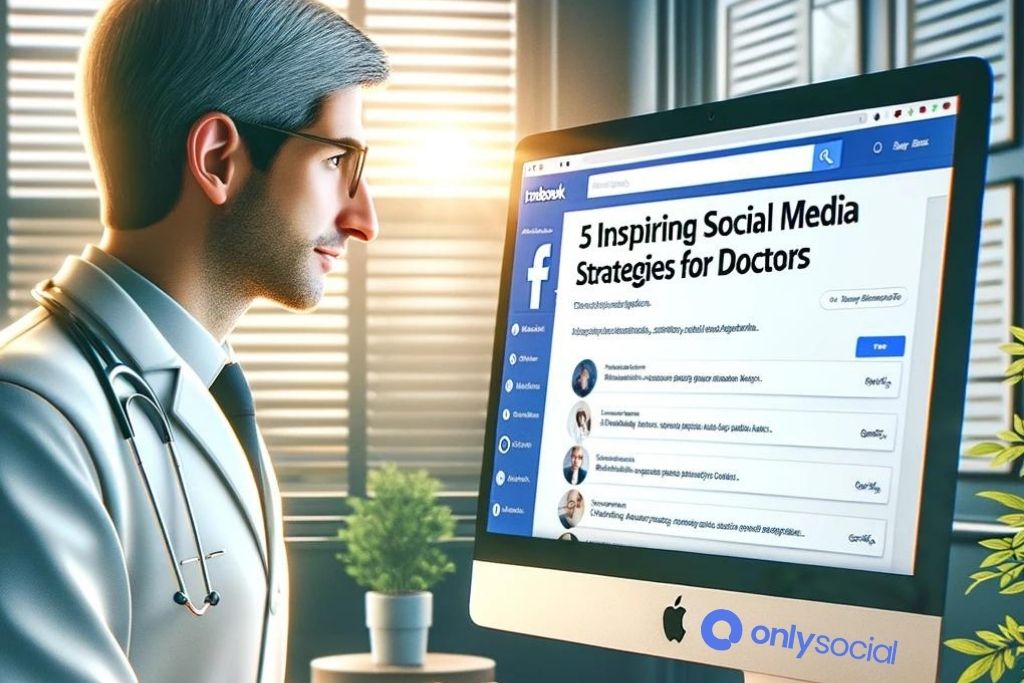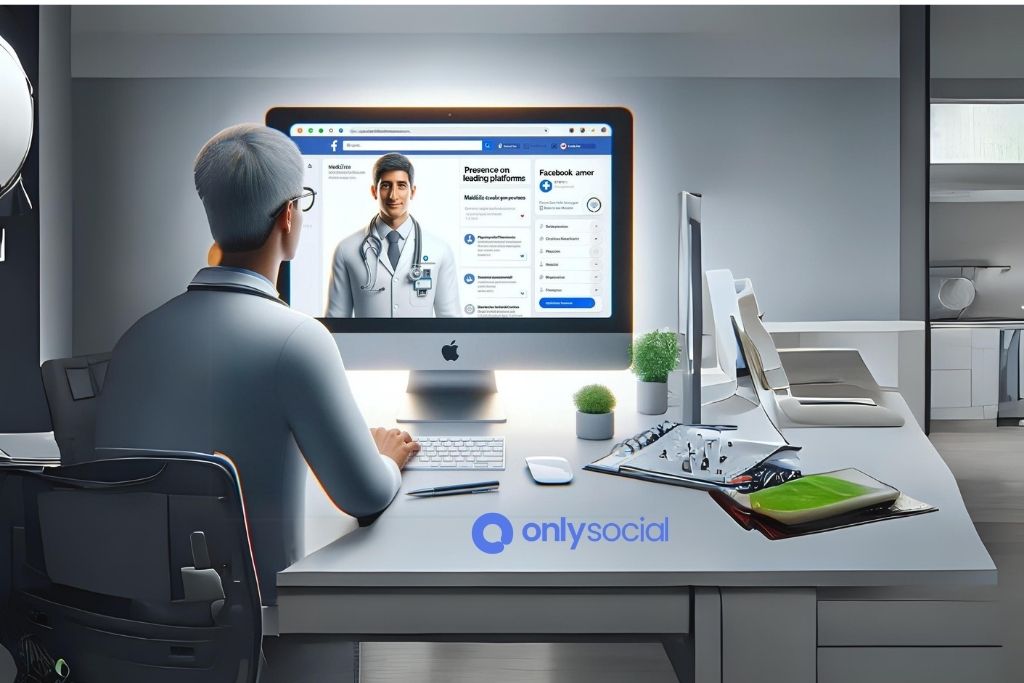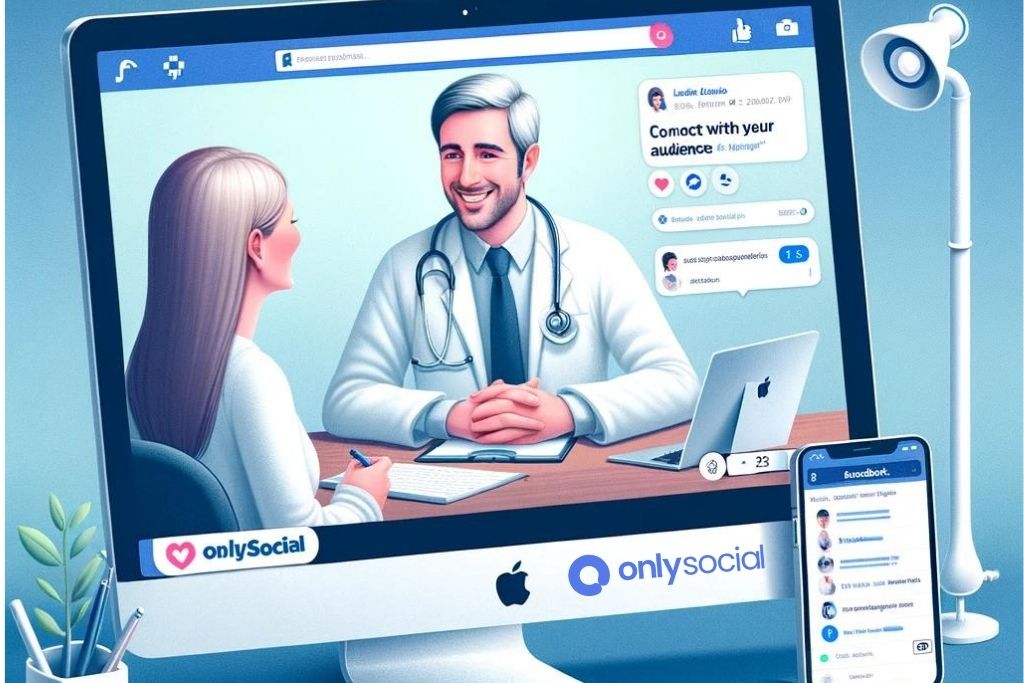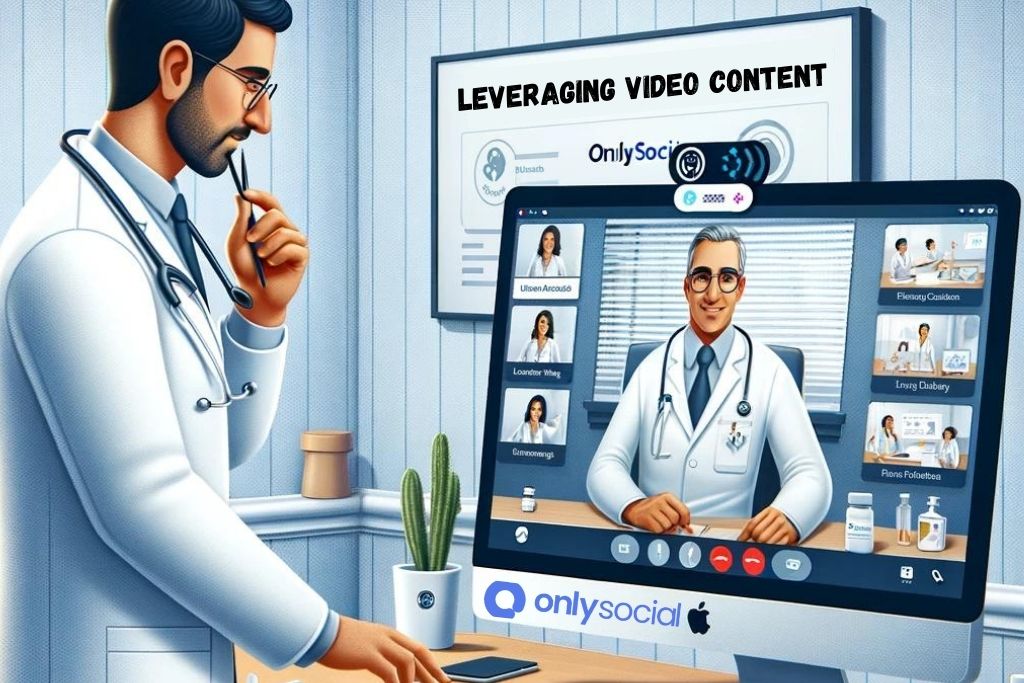5 Inspiring Social Media Strategies for Doctors: Top Platforms and Success Stories

In the digital age, the importance of social media in shaping public perceptions and fostering professional networks has never been more pronounced. For medical professionals, especially, navigating the vast landscape of social media platforms can seem daunting yet is increasingly essential. “5 Inspiring Social Media Strategies for Doctors” aims to demystify this digital realm, offering doctors a roadmap to harness the power of social media effectively. This guide is not just about maintaining an online presence.
it’s about leveraging social media to enhance professional visibility, engage meaningfully with the community, and ultimately, contribute positively to public health discourse. By embracing these strategies, doctors can unlock new avenues for communication, education, and patient engagement, all while upholding the integrity and professionalism inherent to their calling. Whether you’re a seasoned social media user or just starting, these insights will equip you with the tools and confidence needed to make a significant impact in the digital sphere.
Table of Contents
- 1 1. Establishing a Professional Presence on Leading Platforms
- 2 2. Engaging Content Ideas to Connect with Your Audience
- 3 3. Leveraging Video Content for Greater Impact
- 4 4. Building Community and Trust Through Consistent Engagement
- 5 5. Success Stories: Doctors Thriving on Social Media
- 6 BONUS
- 7 Frequently Asked Questions
- 7.0.0.1 What are the best practices for maintaining patient confidentiality on social media?
- 7.0.0.2 How often should doctors post on social media to stay relevant?
- 7.0.0.3 Can social media engagement truly improve patient care?
- 7.0.0.4 How can I measure the success of my social media strategy?
- 7.0.0.5 What type of content is most effective for doctors on social media?
- 7.0.0.6 How can I handle negative comments or misinformation shared on my social media?
- 7.0.0.7 Is it necessary for doctors to be active on multiple social media platforms?
1. Establishing a Professional Presence on Leading Platforms

In the digital age, having a strong online presence is crucial for professionals in any field, including healthcare. For doctors, social media is not just a platform for personal expression but a powerful tool for professional growth, patient education, and networking. Integrating “5 Inspiring Social Media Strategies for Doctors” into your digital routine can transform the way you connect with both peers and patients. This section delves into how doctors can establish a professional presence on leading social media platforms, highlighting the significance of choosing the right platforms and setting up an engaging profile.
Choosing the Right Platforms
The first step in leveraging social media effectively is to identify which platforms are most suited to your professional goals and audience. Here’s a look at the top contenders:
- LinkedIn: Renowned for its professional network, LinkedIn is ideal for doctors looking to connect with peers, join professional groups, and share academic and research-based content.
- Twitter: With its real-time updates, Twitter is perfect for sharing health news, participating in public health conversations, and engaging with a broader community.
- Instagram: A visually driven platform, Instagram allows for the sharing of health tips, behind-the-scenes looks at medical procedures (within privacy guidelines), and patient success stories in an engaging format.
- Facebook: With its vast user base, Facebook offers opportunities to reach a wide audience through informative posts, live Q&A sessions, and patient education groups.
Setting Up Your Profile
After selecting the platforms that align with your objectives, the next crucial step is crafting a profile that reflects your professional identity and engages your intended audience. Here are some tips for setting up a standout profile:
- Professional Profile Picture: Choose a clear, professional headshot that instills trust and conveys friendliness.
- Informative Bio: Your bio should succinctly outline your qualifications, specialties, and the type of content followers can expect from you. Including keywords related to your field can also improve your profile’s visibility in searches.
- Contact Information: Make it easy for professional connections and potential patients to reach you by providing contact information or a link to your practice’s website.
- Consistent Branding: Ensure your profile’s look and feel are consistent across different platforms to build a recognizable personal brand. This includes using a uniform profile picture, cover image, and professional tone in your posts.
Incorporating these “5 Inspiring Social Media Strategies for Doctors” into your approach not only establishes a professional presence online but also sets the stage for meaningful engagement with your audience. By carefully selecting platforms and crafting a profile that showcases your expertise and personality, you can unlock the full potential of social media in your professional life.
2. Engaging Content Ideas to Connect with Your Audience
Implementing engaging content ideas is a cornerstone of the 5 inspiring social media strategies for doctors, aiming to connect more deeply with their audience. Here’s how medical professionals can utilize various content types to educate, inspire, and build trust with their followers.
Educational Content
- Health Tips and Preventative Measures: Share actionable health tips and preventative measures that your audience can incorporate into their daily lives. This could range from nutrition advice to exercises for maintaining a healthy back.
- Medical News and Updates: Keep your followers informed about the latest in medical research, treatments, and healthcare policies. Break down complex information into digestible posts that make it easy for your audience to stay informed.
- Simple Explainer Videos: Use short videos to explain common health conditions, their symptoms, and treatments. These videos can help demystify medical jargon and make healthcare information more accessible.
Behind-the-Scenes Glimpses
- A Day in the Life: Give your followers a peek into your daily routine as a doctor. This could include snapshots of your clinic, preparing for surgeries, or how you unwind after a long day. These glimpses add a personal touch, making you more relatable to your audience.
- Insight into Medical Procedures: Without compromising patient privacy, share general insights into common medical procedures, what they entail, and the recovery process. This can help demystify surgeries and treatments for patients who might be apprehensive.
Patient Success Stories
- Anonymized Testimonials: With patient consent, share success stories that highlight the positive outcomes of treatments. These stories can serve as powerful testimonials to the quality of care you provide and inspire confidence in potential patients.
- Educational Patient Journeys: Detail the journey of anonymized patients from diagnosis to recovery, emphasizing the importance of early detection, treatment options, and the role of patient-doctor collaboration in healthcare.
Live Q&A Sessions
- Host Regular Q&A Sessions: Schedule live sessions where you answer common health questions from your followers. This direct interaction not only helps in educating your audience but also builds a sense of community.
- Specialty Focus Q&As: Occasionally focus these sessions on specific areas of your expertise, offering deeper insights into particular health issues or treatments.
Incorporating these engaging content ideas into your social media strategy can significantly enhance your connection with your audience. By providing valuable information, sharing personal insights, and directly interacting with followers, doctors can leverage social media to foster a trustworthy and informative online presence.
3. Leveraging Video Content for Greater Impact
In today’s digital age, video content has emerged as a powerful tool for engaging and educating audiences, making it a critical component of the “5 Inspiring Social Media Strategies for Doctors.” Here’s how medical professionals can harness the power of video to enhance their social media presence and make a lasting impact on their audience.
Understanding the Power of Video in Healthcare
- Statistics Highlighting Video Engagement: Explore compelling data that showcases the high engagement and retention rates associated with video content on social media platforms. Highlight how videos can effectively communicate complex medical information in an easily digestible format.
- Emotional Connection: Discuss how video content allows doctors to establish a more personal and emotional connection with their audience. This connection is crucial for building trust and credibility in the healthcare sector.
Tips for Creating Compelling Video Content
- Identify Your Audience’s Needs: Begin with understanding the common questions and concerns your audience has. Tailoring your content to address these topics can significantly increase engagement and value.
- Keep It Short and Sweet: Emphasize the importance of brevity in videos. With the average viewer’s attention span being limited, short, impactful videos often perform better.
- High-Quality Production: Stress the importance of clear audio and visuals. While you don’t need expensive equipment, ensuring your videos are easy to watch and listen to is key.
- Engage with a Friendly Demeanor: Encourage doctors to be relatable and approachable in their videos. A friendly and reassuring tone can make complex medical advice more accessible.
Video Content Ideas for Doctors
- Educational Series: Suggest creating a series of short videos that cover a wide range of health topics, from preventive care to managing chronic diseases. Each video can be a standalone topic or part of a larger series.
- FAQ Sessions: Highlight the potential of hosting regular FAQ sessions where doctors answer common health questions submitted by their followers. This not only provides valuable information but also fosters a sense of community.
- Behind-the-scenes: Offer insights into the daily life of healthcare professionals. This could include tours of new clinic facilities, introductions to medical staff, or demonstrations of how common medical equipment works.
- Patient Education: Discuss the importance of patient education videos that explain common procedures or how to prepare for surgery. These videos can help demystify the medical process and ease patient anxieties.
Enhancing Engagement Through Video
- Call to Action: Encourage viewers to engage with the content by asking questions, sharing their experiences, or suggesting topics for future videos. This interaction can provide valuable feedback and further content ideas.
- Share Across Platforms: Advice on the benefits of sharing video content across various social media platforms to reach a wider audience. Each platform has its unique features and audience preferences, so tailoring the video format and message to each platform can maximize impact.
Incorporating video content into a doctor’s social media strategy can significantly enhance their ability to educate, engage, and connect with their audience. By following these guidelines, doctors can create impactful video content that complements their overall social media presence, aligning to provide “5 Inspiring Social Media Strategies for Doctors.”
4. Building Community and Trust Through Consistent Engagement
In the digital age, where personal connection often takes a backseat to online interactions, doctors face the unique challenge of bridging the gap between professional authority and personal engagement. The key to mastering this balance lies within one of the 5 inspiring social media strategies for doctors: building community and trust through consistent engagement. This approach not only humanizes physicians in the eyes of their audience but also fosters a sense of trust and reliability—crucial components in the doctor-patient relationship.
Engaging with Your Online Community
Consistent engagement on social media platforms can take various forms, from the simple act of responding to comments and messages to actively participating in health-related discussions. Doctors can use these opportunities to address general health concerns, debunk medical myths, and share valuable health tips, thereby providing a public service that extends beyond the confines of their practice. This direct interaction not only demonstrates a doctor’s commitment to their followers’ well-being but also builds a supportive online community.
Personalizing Your Responses
The power of personalization cannot be overstated. When doctors take the time to craft personalized responses, even to simple queries, it conveys a level of care and attention that resonates deeply with individuals. This personalized approach, while time-consuming, significantly enhances the perceived value of the interaction, further cementing the trust between doctors and their social media followers.
Encouraging Healthy Discussions
Creating a safe space for discussions about health and wellness is another pivotal aspect of engaging with an online community. By initiating conversations on important health topics and encouraging followers to share their experiences and questions, doctors can foster a sense of belonging and community. This engagement strategy not only helps in spreading accurate health information but also in combating the spread of misinformation, a rampant issue in the realm of online health advice.
Collaborating with Peers
Engagement on social media isn’t limited to interactions with patients and the general public. Doctors can further enrich their online communities by collaborating with other healthcare professionals. Through guest posts, joint live sessions, or panel discussions, doctors can offer their followers a broader perspective on health issues, introduce them to different specialties, and provide a more comprehensive understanding of various health topics.
Regularly Updating Your Audience
Consistency is key to keeping the audience engaged and building a lasting community. Regular updates, whether through posts, stories, or videos, keep followers informed and interested in the content being shared. This consistent presence not only helps to maintain the visibility of a doctor’s social media profile but also reinforces its reliability as a trusted source of health information.
Incorporating these strategies into their social media engagement can help doctors significantly in building a trusting and loyal online community. By prioritizing interaction, personalization, and collaboration, physicians can enhance their digital presence, offering both valuable health information and a reassuring sense of community to their followers.
5. Success Stories: Doctors Thriving on Social Media
Exploring the impact of “5 Inspiring Social Media Strategies for Doctors,” this section delves into real-life examples of healthcare professionals who have masterfully harnessed the power of social media to elevate their practice, connect with patients, and share valuable health information. Their journeys illustrate the potential of social media as a tool for medical professionals to extend their influence beyond the clinic’s walls.
Dr. A: The Instagram Educator
- Platform of Choice: Instagram
- Strategy: Utilizing visually engaging content, including infographics and short video clips, to explain complex medical concepts in simple, understandable language.
- Outcome: Dr. A has become a go-to source for health education on Instagram, amassing a large following that actively engages with each post, leading to increased awareness of various health issues and prevention measures.
Dr. B: The Twitter Health Advocate
- Platform of Choice: Twitter
- Strategy: Leveraging Twitter’s rapid-fire communication style to share the latest health news, advocate for public health measures, and engage in conversations with both patients and peers.
- Outcome: Dr. B’s timely updates and active participation in health-related discussions have established them as a thought leader in their field, fostering a community of informed followers.
Dr. C: The YouTube Wellness Guru
- Platform of Choice: YouTube
- Strategy: Creating detailed video content that covers a wide range of topics, from wellness tips to deep dives into medical conditions, all aimed at promoting a healthier lifestyle.
- Outcome: Through consistent posting and high-quality content, Dr. C has built a loyal subscriber base that values their expert advice, significantly increasing their reach and impact on public health education.
Dr. D: The LinkedIn Networker
- Platform of Choice: LinkedIn
- Strategy: Focusing on professional networking, Dr. D shares insights into the healthcare industry, career advice for medical professionals, and highlights from their clinical practice.
- Outcome: This approach has not only broadened Dr. D’s professional network but also positioned them as a mentor within the medical community, leading to opportunities for collaboration and growth.
Dr. E: The Facebook Community Leader
- Platform of Choice: Facebook
- Strategy: Building a community around a specific health topic, offering support, and sharing evidence-based information to educate and empower members.
- Outcome: Dr. E’s active management of this group has created a safe space for individuals to seek advice, share experiences, and gain access to reliable health information, strengthening the bond between the doctor and the community.
These success stories underscore the versatility and power of social media in the medical field. Each doctor’s unique approach to “5 Inspiring Social Media Strategies for Doctors” demonstrates how tailored content, when combined with strategic platform use, can lead to significant professional achievements and a positive impact on public health.
BONUS
Leveraging OnlySocial’s Post Planning and Scheduling feature can elevate your social media strategy, allowing for effortless management of unlimited profiles and posts. Ensure your content reaches your audience at the right time, maximizing impact. Try it now with a commitment-free 7-day trial today.
Frequently Asked Questions
Always adhere to HIPAA and other relevant privacy laws by never sharing identifiable patient information without explicit consent. Use generic terms and avoid specifics that could inadvertently reveal a patient’s identity. When sharing patient stories or testimonials, obtain written consent and consider using anonymized narratives.
Consistency is key. Aim for a regular posting schedule that fits your availability and the expectations of your audience. This could range from daily posts on platforms like Twitter to 1-2 times per week on LinkedIn or Instagram, depending on your content strategy and capacity to engage.
Yes, by providing accessible health education, fostering a sense of community, and encouraging health awareness and preventive practices, social media can complement traditional patient care. It also offers a platform for direct communication and support, enhancing the patient-doctor relationship.
Use platform-specific analytics tools to track engagement metrics such as likes, shares, comments, and follower growth. Also, pay attention to the quality of interactions and feedback from your audience. Setting clear objectives (e.g., increasing awareness, education, or patient engagement) will help you assess whether your social media efforts are meeting your goals.
Content that educates, informs, and engages your audience is most effective. This can include health tips, myth-busting, patient success stories (with consent), Q&A sessions, and behind-the-scenes looks into the medical profession. Tailor your content to the interests and needs of your target audience while ensuring it’s accessible and easy to understand.
Approach negative comments professionally and constructively, offering to address concerns privately if necessary. For misinformation, provide correct, evidence-based information respectfully. Establishing clear community guidelines for interactions on your platforms can also help manage such situations.
While being active on multiple platforms can increase your reach, it’s more important to focus on where you can maintain consistent, quality engagement. Choose platforms based on where your target audience is most active and where you can best share your expertise and content. Quality over quantity is a good rule of thumb.


